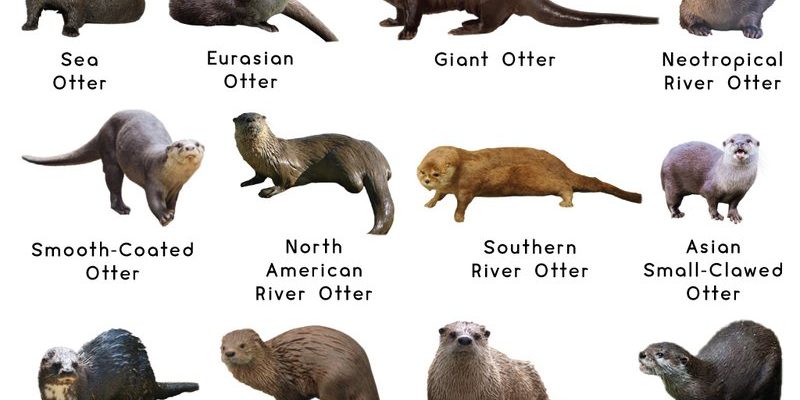![Comparing The River Otter Vs. [Similar Species]](https://gudri.com/wp-content/uploads/2025/06/Comparing_The_River_Otter_Vs___Similar_Species__image_0.jpg)
River otters and sea otters may share a family name—Mustelidae—but they each have their own unique lifestyle, diet, and habitat. Finding similarities is fun, but understanding their distinct characteristics can give us greater appreciation for these animals and their roles in the ecosystem. Grab a cup of coffee, settle in, and let’s take a closer look at these amazing creatures!
Habitat: Different Waters, Different Lives
The river otter thrives in freshwater environments. You’ll typically find them in streams, rivers, lakes, and wetlands. These playful animals are well-adapted to life on land and water. They love to slide down mud and snowbanks, showcasing their agility and playful nature. Spotting a river otter is usually easier in these ecosystems, as they often venture onto the banks to rest or play.
On the flip side, sea otters call the coastal ocean their home. They can be seen floating on their backs in the chilly waters of the Pacific Ocean, often wrapped in kelp to keep them anchored. Sea otters are especially fond of rocky shorelines and coastal areas where they can dive for food. Their habitat provides them with not just a playground, but also a buffet of marine life.
Understanding the habitat preferences of these two otters helps us to appreciate their different lifestyles. While river otters might seem more versatile, sea otters are uniquely suited to marine environments, where they dominate the food chain.
Physical Appearance: Look Closer
At first glance, river otters and sea otters might look similar, but look a little closer, and you’ll notice some distinct features. River otters are generally longer and slimmer, with a body length of about 2 to 3 feet. They have sleek fur, usually in shades of brown, which helps them blend into their freshwater environments.
Sea otters, on the other hand, have a more robust body and a shorter, fluffier coat. Their size ranges from 50 to 100 pounds, making them significantly heavier than river otters. The fur of a sea otter is incredibly thick—up to a million hair strands per square inch! This adaptation helps to keep them warm in cold ocean waters.
So next time you spot one of these otters, remember their physical traits tell a story about their environment and lifestyle.
Diet: What’s on the Menu?
When it comes to dining, river otters are versatile eaters. Their diet mainly consists of fish, but they aren’t picky. They also enjoy crustaceans, amphibians, and small mammals. River otters are excellent hunters; they can dive underwater for as long as eight minutes while chasing their meals. Isn’t that impressive?
Sea otters, conversely, are picky eaters with a preference for marine invertebrates. They feast on sea urchins, crabs, clams, and octopuses. What’s fascinating is that sea otters use tools to crack open shells. Yes, you heard that right! They often grab a rock and use it to break open a difficult shellfish—now that’s creativity in action!
Both otters play a significant role in their ecosystems, but their dietary preferences highlight how each species has adapted to their specific environments.
Social Behavior: Fun and Family Life
In terms of social behavior, river otters are typically more outgoing. They often live in family groups, especially when raising their young. You might see them playing together, swimming side by side, and engaging in wrestling matches, which certainly adds a touch of sweetness to the riverbanks.
Sea otters, however, are a bit more solitary. Although they can form rafts—groups that float together—they often prefer to hang out alone. Sea otters also exhibit unique behaviors, like holding hands while they sleep, preventing them from drifting apart in the ocean. This endearing trait showcases their gentle side and emphasizes the importance of companionship in their often challenging environment.
Both species enjoy their social interactions, but how they connect reflects their specific lifestyles and habitats.
Conservation Status: Protecting Our Playful Friends
The conservation status of river and sea otters tells a broader story about wildlife protection. River otters, once seriously threatened by habitat loss and pollution, have made a comeback in many areas thanks to conservation efforts. Today, they’re classified as “least concern” by the IUCN, indicating that their populations are stable.
In contrast, sea otters have faced significant challenges. They were nearly hunted to extinction for their luxurious fur. Today, their conservation status is listed as “endangered” in many regions. Efforts to protect their habitat and ban harmful fishing practices continue to be crucial to their survival.
Understanding the conservation statuses of both species can help us appreciate the ongoing work to protect these wonderful creatures and their habitats.
So, that’s a wrap on our playful comparison of the river otter and sea otter. Both species are delightful in their own right and play unique roles in their ecosystems. From the river otter’s playful antics on land to the sea otter’s impressive tool use in the ocean, there is so much to admire.
By learning more about these incredible animals, we not only deepen our understanding of them, but we also become more aware of the importance of preserving their environments. As we move forward, let’s celebrate these aquatic companions and contribute to their protection, ensuring future generations can enjoy their charm and wonder.

